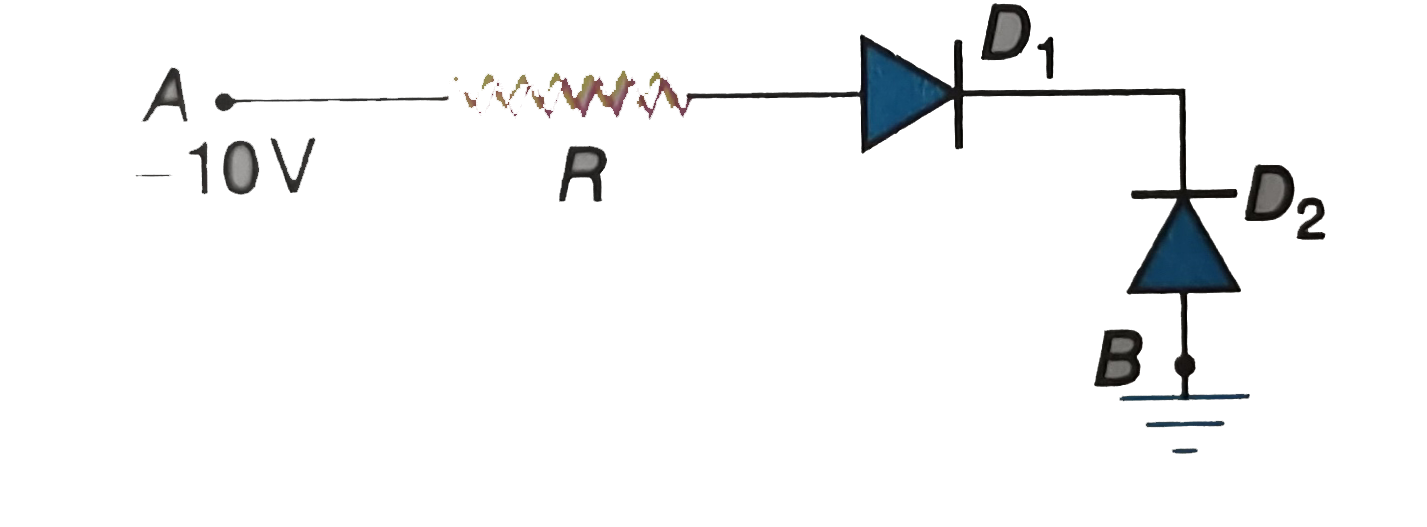In an intrinsic semiconductor the energy gap Eg is 1.2 eV. Its hole mobility is much smaller than electron mobility and independent of temperature. What is the ratio between conductivity at 600 K and that at 300 K? Assume that the temerature dependence of intrinsic carrier concentration ni is given by
ni=n0exp(−Eg2kBT) where n0is a constant.Solution in Bengali
Let K1andK2 be the conductivity of the material at 600 K and 300 K respectively.
K1K2=n1n2=n0e−Eg2kBT1n0e−Eg2kBT2=eEg2kB(1T2−1T1)
[Here,Eg2kB(1T2−1T1)=1.22×8.6×10−5(1300−1600)]
=11.6279
∴K1K2=e11.6279=1.12×105
Topper's Solved these Questions
- SEMICONDUCTORS AND ELECTRONICS BOOK - CHHAYA PUBLICATIONCHAPTER - SEMICONDUCTORS AND ELECTRONICS EXERCISE - NCERT EXEMPLAR QUESTIONS WITH ANSWER HINT (Single Option Correct )
6 Videos
- SEMICONDUCTORS AND ELECTRONICS BOOK - CHHAYA PUBLICATIONCHAPTER - SEMICONDUCTORS AND ELECTRONICS EXERCISE - NCERT EXEMPLAR QUESTIONS WITH ANSWER HINT (Multiple Options Correct )
1 Videos
- SEMICONDUCTORS AND ELECTRONICS BOOK - CHHAYA PUBLICATIONCHAPTER - SEMICONDUCTORS AND ELECTRONICS EXERCISE - HIGHER ORDER THINKING SKILL (HOTS) QUESTIONS
18 Videos
- REFRACTION OF LIGHTBOOK - CHHAYA PUBLICATIONCHAPTER - REFRACTION OF LIGHTEXERCISE - CBSE SCANNER
11 Videos
Similar Questions
In Fig 1.50 assuming the diodes to be ideal

View SolutionConsider an n-p-n transistor with its base -emitter junction forward biased and collector -base junction reverse biased. Which of the following statements are true ?
View SolutionWhen a semiconductor is irradiated by light of definite wavelength its resistance decreases.Exaplain why.
View SolutionFor the same angle of incidence, the angles of refraction in three different media A, B and C are15∘,25∘ and 35∘ respectively. In which medium, will the velocity of light be minimum ?
View SolutionIn an intrinsic semiconductor, the energy gap Eg of an intrinsic semiconductor is 1.2 eV. Its hole mobility is very much smaller than electron mobility and is indepndent of temperature. What is the ratio between conductivity at 600K and at 300K? Assume that the temperature dependence of intrinsic concentraction ni is expressed as,
ni=noe−E′g/kBT, where no is constant and E′g is an energy equal to Eg/2,
kB=8.62×10−6eVK−1.
View SolutionIn an intrinsic semiconductor, the energy gap Eg of an intrinsic semiconductor is 1.2 eV. Its hole mobility is very much smaller than electron mobility and is indepndent of temperature. What is the ratio between conductivity at 600K and at 300K? Assume that the temperature dependence of intrinsic concentraction ni is expressed as,
ni=noe−E′g/kBT, where no is constant and E′g is an energy equal to Eg/2,
kB=8.62×10−6eVK−1.
View SolutionA semiconductor having electron and linear mobilities mu_(n) and mu_(p) respectively. If its intrinsic carrier density is n_(i) , then what will be the value of hole concentration P for which the conductivity will be maximum at a given temperature?
View SolutionThe energy gap of pure Si is 1.1 eV The mobilities of electrons and holes are respectively 0.135 m^(2) V^(-1) s^(-1) and 0.048 m^(2) V^(-1) s^(-1) and can be taken as independent of temperature. The intrinsic carrier concentration is given by n_(i) = n_(0) e^(-Eg//2kT) . Where n_(0) is a constant, E_(g) The gap width and k The Boltmann's constant whose vaue is 1.38 xx 10^(-23) JK^(-1) The ratio of the electrical conductivities of Si at 600 K and 300 K is.
View Solutionकिसी नीज अर्द्धचालक में ऊर्जा अंतराल Eg का मान 1.2eV है । इसकी होल गतिशीलता इलेक्ट्रान गतिशीलता की तुलना में काफी काम है तथा ताप पर निर्भर नहीं है । इसकी 600K तथा 300K पर चालकताओ का क्या अनुपात है ? यह मानिए कि निज वाहक सांद्रता N(i) की ताप निर्भरता इस प्रकार व्यक्त होती है :
ni=n0exp.(−Eg2KT)
जहाँ n0 एक स्थिरांक है ।
View SolutionIn an intrinsic semiconductor the energy gapEg is1.2 eV. Its hole mobility is much smaller than electron and independent of temperature. What is the ratio between conductivity at 600 K and that at 300 K? Assume that the temperature dependence of intrinsic carrier concentration ni is given by ni=no exp(−Eg2KBTT) where n0 is a constant .
View SolutionIf ncandnh are electron and hole concentralious in an extrinsic semiconductor and ni is electron concentrations in an intrinsic semiconductor, then
View SolutionIf neandnh are electron and hole concentrations in an extrinsic semiconductor and ni is electron concentration in an intrinsic semiconductor then.
View SolutionIn an intrinsic semiconductor , the energy gap E_(g) is 1.2 eV . Its hole mobility is much smaller than electron mobility and independent of temperature . What is the ratio between conductivity of 600 K and that at 300 K ? Assume that the temperature dependence of intrinsic carrier concentration n_i is given by n_(i)=n_(0) exp ((-E_(g))/(k_T)), where n_(0) is a constant and k_=8.62xx10^(-5)eV//K.
View SolutionIn an intrinsic semiconductor the energy gap Eg is 1.2eV. Its hole mobility is much smaller than electron mobility and independent of temperature. What is the ratio between conductivity at 600K and that at 300K? Assume that the temperature dependence of intrinsic carrier concentration n_(i) is given by: n_(i) = n_(o) "exp" (-E_(g)/(2k_(B)T)) Where n_(0) is a constant.
View SolutionIn an intrinsic semiconductor the energy gap Eg is 1.2eV. Its hole mobility is much smaller than electron mobility and independent of temperature. What is the ratio between conductivity at 600K and that at 300K? Assume that the temperature dependence of intrinsic carrier concentration ni is given by:
ni=noexp(−Eg2kBT)
Where n0 is a constant.
View Solution
